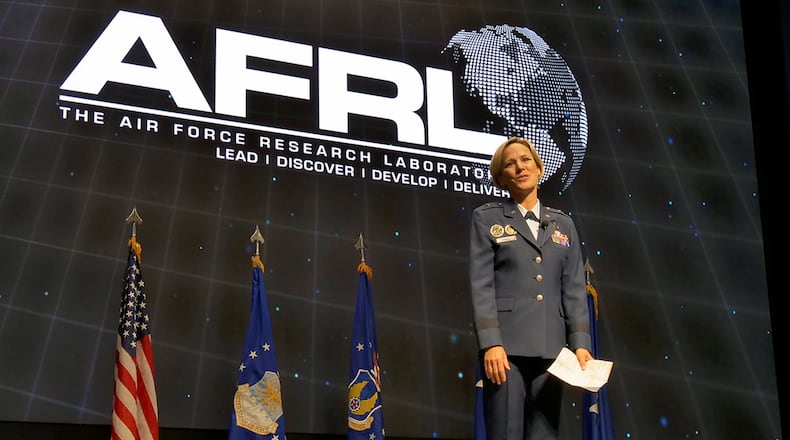AFRL is based at Wright-Patterson, making the base not just Ohio’s largest single-site employer with 30,000 military and civilian employees, but an increasingly crucial base for two military branches.
AFRL’s orientation requires new strategies, investment goals and adaptation. “We wanted to make sure we took a clean slate approach,” Pringle said.
AFRL has 300 Space Force Guardians already in its ranks, Pringle said. By late summer or early fall, the lab expects to have more than 700 Guardians on the team.
“That ‘s just a snapshot of how important or how implicated the Space Force requirements are going to be to our future way of doing business,” the commander said.
It’s about making sure AFRL-borne technology and research work for both services, she added, going on to quote Gen. Arnold Bunch, commander of Air Force Materiel Command (AFMC).
“Ultimately, being an AFRL for two services made sense because, as my boss Gen. Bunch likes to say, ‘A technology doesn’t know its application until you tell it,’” Pringle said.
AFMC, like AFRL, is anchored at Wright-Patterson.
Joel Mozer, the Space Force’s chief scientist, noted in the roundtable that Space Force is quite young. “We’re just over a year, approaching a year-and-a-half-old.”
And quite small. There are about 4,000 to 5,000 civilians assigned to Space Force, with about an equal number of uniformed personnel assigned to it. Even if Space Force grows to 15,000 members, it will still be a relatively small service, Mozer said, about a quarter of the size of the U.S. Coast Guard.
By comparison, the Air Force had 329,839 active-duty members as of Oct. 2020, 64,025 officers and 265,814 enlisted personnel.
“We’re lean and we’re agile, and that’s all by design,” Mozer said, referring to Space Force.
There are some 3,300 active satellites in orbit, with about 1,900 of those U.S.-flagged, Mozer said. Of those 1,900, about 1,500 are commercial. The remaining 400 belong to the military or civil governments. A weather satellite costs about $290 million to produce, with about $100 million to get into orbit, he said.
Bottom line, that adds up to a lot of U.S. treasure or assets tied up in orbit, Mozer said.
“Why wouldn’t you want a service to protect those assets,” he said. “And that doesn’t even include the $360 billion a year or so that represents the revenue that’s brought in from the commercial satellites. That’s a big deal.”
If war does extend in space, “We need to be in a position to dominate and win that year,” he added. “That’s where the technology comes in, and that’s why we’re very much enthused about AFRL leading our technology efforts for us.”
He added: “Change is going to come very fast, and we need to be leading that change and be at the forefront of it.”
Pat Roach, chief scientist of the Air Force Office of Scientific Research, said AFRL will have to grow space-oriented research to meet Space Force’s needs.
And Stacie Williams, the Air Force Office of Scientific Research’s space science architect, recalled that in the 1991 Gulf War, the world saw the advantage the “space domain” brought to warfighting.
Global positioning satellites are second nature today, but that technology was built on basic Air Force research in the 1960s, Williams said. Lasers and imaging technologies are all built on investments the Air Force made in basic research, she said.
Artificial intelligence or “AI” is increasingly another area of focus. Mozer said both branches can harness AI to “free up” humans to do what he said humans do best, which is resolve ambiguity and examine questions of ethics.
All AFRL programs are examining their scientific portfolios with an eye toward applications for the Space Force. “We’re in the midst, and it’s an ongoing continuous process,” Pringle said.
Also scheduled Wednesday is “AFRL Inspire,” a two-hour event with eight TEDx-style talks. Mozer will be a guest speaker, and the event will be livestreamed from the Air Force Institute of Technology’s Kenney Hall Auditorium starting at 2 p.m.
The livestreamed event can be seen at AFRL’s Facebook page at www.facebook.com/AFResearchlab.
About the Author


